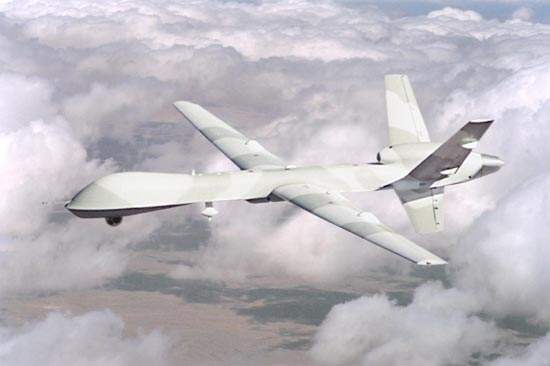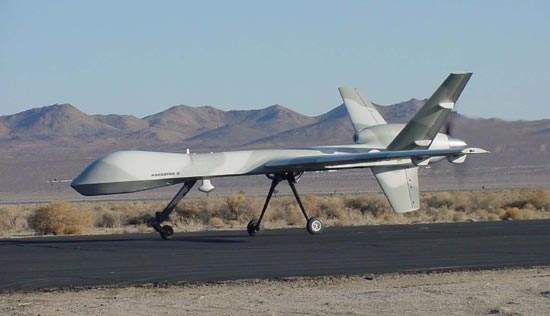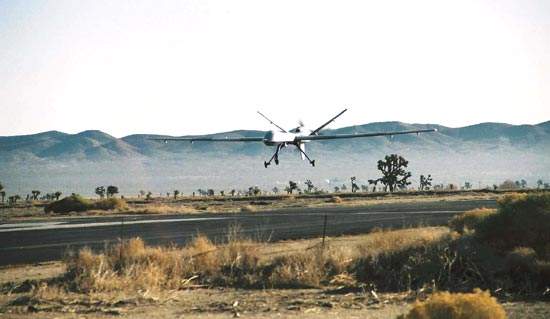The RQ-1 Predator UAV is a long-endurance, medium-altitude unmanned aircraft system for surveillance and reconnaissance missions. Surveillance imagery from synthetic aperture radar, video cameras and a forward-looking infrared (FLIR) can be distributed in real-time both to the front line soldier and to the operational commander, or worldwide in real-time via satellite communication links. MQ-1, armed with AGM-114 Hellfire missiles, is the multi-role version which is used for armed reconnaissance and interdiction.
A contract was awarded to General Atomics Aeronautical Systems in January 1994 to execute the Tier II, medium-altitude endurance Predator programme. The Predator system first flew in 1994 and entered production in August 1997.
Predators are currently in production for the US Air Force and are operational with the USAF 11th and 15th Reconnaissance Squadrons. Over 125 Predators have been delivered to the USAF. 36 additional MQ-1B Predators (with Hellfire missile installation kits) were ordered in September 2007. Six Predator UAVs are in service with the Italian Air Force. Italian company Meteor was responsible for assembly of five of the six. The Italian system was deployed to Iraq in January 2005.
Predator UAVs have been operational in Bosnia since 1995 in support of Nato, UN and US operations and as part of Operation Enduring Freedom in Afghanistan and Operation Iraqi Freedom, flying over 500,000 flight hours on over 50,000 flights. The MQ-1 Predator achieved initial operating capability (IOC) in February 2005.
General Atomics is the prime contractor and the main subcontractors include: Versatron / Wescam for the electro-optical Skyball Gimbal; Northrop Grumman for the synthetic aperture radar; L3 Communication for the wideband satellite communications link; and Boeing for the intelligence workstation and mission planning system.
MQ-1B Predator UAV with Hellfire missile
In February 2001, the Hellfire-C laser-guided missile was successfully fired from a Predator air vehicle in flight tests at Nellis air force base, Nevada. In November 2002 in Yemen, a Predator UAV was used to drop a Hellfire missile which destroyed a civilian vehicle carrying suspected terrorists. A Northrop Grumman Bat submunition was successfully dropped and a FINDER mini-UAV launched from a Predator UAV in August 2002.
MQ-9 Reaper Hunter / Killer UAV
In May 1998 General Atomics was awarded a block 1 upgrade contract to expand the capabilities of the Predator system. System upgrades include development of an improved relief-on-station (ROS) system which allows continuous coverage over areas of interest without any loss of time on station, secure air traffic control voice relay, Ku-band satellite tuning and implementation of an air force mission support system (AFMSS).
The upgrade also covers a more powerful turbocharged engine and wing de-icing systems to enable year-round operations. The upgraded Predator, the Predator B, has been operational in the Balkans since April 2001. In March 2005, the USAF awarded a further contract for the system design and development (SDD) of MQ-9 Reaper Hunter / Killer. 21 MQ-9 have been ordered and eight delivered to the USAF.
The first USAF MQ-9 squadron, the 42nd Attack Squadron, was formed in March 2007. It is based at Creech AFB in Nevada.
The USAF first deployed the MQ-9 Reaper to Afghanistan in October 2007, where it is being used for precision strikes. The MQ-9 Reaper flew its first operational mission in Iraq in July 2008.
The MQ-9 Reaper has an operational ceiling of 50,000ft, a maximum internal payload of 800lb and external payload over 3,000lb. It can carry up to four Hellfire II anti-armour missiles and two laser-guided bombs (GBU-12 or EGBU-12) and 500lb GBU-38 JDAM (joint direct attack munition). In May 2008, a USAF Reaper successfully test dropped four Raytheon GBU-49 Enhanced Paveway II 500lb bombs, which have laser and GPS guidance.
The MQ-9 sensor payload can include the General Atomics Lynx SAR (synthetic aperture radar). Lynx also features ground moving target indicator technology. The Predator is to be flight tested with a L-3 communications tactical common datalink (TCDL).
In September 2012, the Block 1-plus Predator B/MQ-9 Reaper successfully completed its first flight. It is an upgraded version of the Block 1 Predator B. The new configuration features increased electrical power and Gross Takeoff Weight (GTOW), upgraded electrical system and new communications systems.
Predator B Sky Warrior UAV
In August 2005, a version of Predator B, called Sky Warrior, was chosen for the four-year system development and demonstration (SDD) phase of the US Army’s extended range / multi-purpose (ER/MP) UAV programme – 11 Sky Warrior systems, each with 12 air vehicles and five ground control stations.
Initial operating capability is planned for 2009. Two block 0 Sky Warrior UAVs were deployed to Iraq in April 2008.
Also in August 2005, the US Department of Homeland Security / Customs and Border Protection (DHS/CBP) ordered two Predator B systems for monitoring of the USA’s south-west border. The first was delivered in late 2005, the second in September 2006. Two further systems were ordered in October 2006, for monitoring operations on the border with Canada.
In September 2006, the UK requested the foreign military sale (FMS) of two MQ-9 Reaper systems with Lynx SAR, multi-spectral targeting systems and one ground station. Deliveries began in mid-2007 and the RAF deployed the system in Afghanistan in November 2007. In January 2008, the UK requested the sale of an additional ten MQ-9 systems.
In August 2008, Italy requested the sale of four MQ-9 Reaper systems with three ground stations.
System components
A typical Predator system configuration would include four aircraft, one ground control system and one Trojan Spirit II data distribution terminal. The Predator air vehicle is 27ft in length and has a 49ft wingspan. The system operates at an altitude of 25,000ft and at a range of 400nm.
The endurance of the air vehicle is more than 40 hours and the cruise speed is over 70kt. The air vehicle is equipped with UHF and VHF radio relay links, a C-band line-of-sight data link which has a range of 150nm and UHF and Ku-band satellite data links.
Payload
The surveillance and reconnaissance payload capacity is 450lb and the vehicle carries electro-optical and infrared cameras and a synthetic aperture radar. The two-colour DLTV television is equipped with a variable zoom and 955mm Spotter. The high resolution FLIR has six fields of view, 19mm to 560mm.
The Raytheon multi-spectral targeting system (MTS-A) is fitted on the MQ-1/9 Predator. The MTS-A provides real-time imagery selectable between infrared and day TV as well as a laser designation capability. MQ-1 can employ two laser-guided Hellfire anti-armour missiles with the MTS.
The Northrop Grumman TESAR synthetic aperture radar is fitted on the MQ-1 and provides all-weather surveillance capability, has a resolution of 1ft. Other payload options, which can be selected to meet mission requirements, include a laser designator and rangefinder, electronic support and countermeasures and a moving target indicator (MTI).
The USAF equipped a number of MQ-1 and MQ-9 Predators with a version of the Northrop Grumman airborne signals intelligence payload (ASIP) in 2010. Northrop Grumman was awarded a contract for the development and flight testing of the system on an MQ-1 in April 2008. ASIP was tested on the U-2 reconnaissance aircraft and was also fitted on the RQ-4 Global Hawk.
Ground station
The UAV ground control station is built into a single 30ft trailer, containing pilot and payload operator consoles, three Boeing data exploitation and mission planning consoles and two synthetic aperture radar workstations together with satellite and line-of-sight ground data terminals.
The ground control station can send imagery data via a landline to the operational users or to the Trojan Spirit data distribution system which is equipped with a 5.5m dish for Ku-band ground data terminal and a 2.4m dish for data dissemination.
Operation
Predator follows a conventional launch sequence from a semi-prepared surface under direct line-of-sight control. The take-off and landing length is typically 2,000ft. The mission can be controlled through line-of-site data links or through Ku-band satellite links to produce continuous video.
Video signals received in the ground control station are passed to the Trojan Spirit van for worldwide intelligence distribution or directly to operational users via a commercial global broadcast system. Command users are able to task the payload operator in real-time for images or video on demand.






